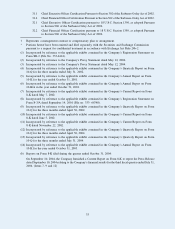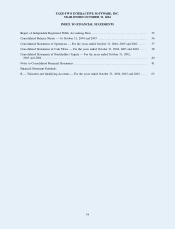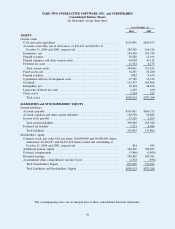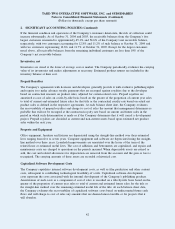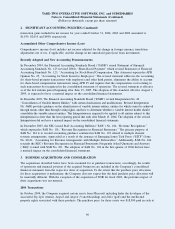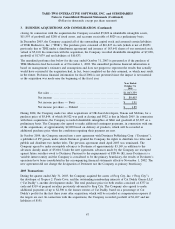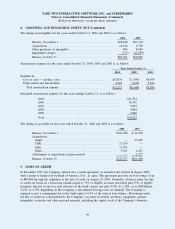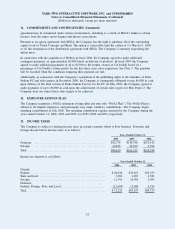2K Sports 2004 Annual Report Download - page 51
Download and view the complete annual report
Please find page 51 of the 2004 2K Sports annual report below. You can navigate through the pages in the report by either clicking on the pages listed below, or by using the keyword search tool below to find specific information within the annual report.
Goodwill and Intangible Assets
Goodwill is the excess purchase price paid over identified intangible and tangible net assets of acquired
companies. Intangible assets consist of trademarks, intellectual property, non-compete agreements, customer
lists and acquired technology. Certain intangible assets acquired in a business combination are recognized as
assets apart from goodwill. Identifiable intangibles are amortized using the straight-line method over the
period of expected benefit ranging from three to ten years, except for intellectual property, which is amortized
based on the shorter of the useful life or expected revenue stream. Intangible assets with indefinite lives, if
any, and goodwill are not amortized.
The Company performs an annual test for impairment of goodwill, in the fourth quarter of each fiscal year.
The Company determines the fair value of each reporting unit using discounted cash flow analysis and
compares such values to the respective reporting unit’s carrying amount. At October 31, 2004 and 2003, the
fair value of the Company’s reporting units exceeded the carrying amounts and no impairment was indicated.
Impairment of Long-Lived Assets
The Company reviews all long-lived assets whenever events or changes in circumstances indicate that the
carrying amount of an asset may not be recoverable, including assets to be disposed of by sale, whether
previously held and used or newly acquired. The Company compares the carrying amount of the asset to the
estimated undiscounted future cash flows expected to result from the use of the asset. If the carrying amount
of the asset exceeds estimated expected undiscounted future cash flows, the Company records an impairment
charge for the difference between the carrying amount of the asset and its fair value. The estimated fair value
is generally measured by discounting expected future cash flows at the Company’s incremental borrowing rate
or fair value, if available.
Income Taxes
The Company recognizes deferred taxes under the asset and liability method of accounting for income taxes.
Under the asset and liability method, deferred income taxes are recognized for differences between the
financial statement and tax bases of assets and liabilities at currently enacted statutory tax rates for the
years in which the differences are expected to reverse. The effect on deferred taxes of a change in tax rates
is recognized in income in the period that includes the enactment date. Valuation allowances are established
when necessary to reduce deferred tax assets to the amounts expected to be realized after considering tax
planning strategies, if applicable. No income taxes have been provided on the undistributed earnings of
foreign subsidiaries, as such earnings are expected to be permanently reinvested in those companies.
Revenue Recognition
The Company earns its revenue from the sale of internally developed interactive software titles and from the sale
of titles licensed from third-party developers (“Publishing revenue”). The Company also earns revenue from the
sale of interactive software titles published by third parties, hardware and accessories (“Distribution revenue”).
The Company recognizes revenue upon the transfer of title and risk of loss to its customers. The Company
applies the provisions of Statement of Position 97-2, “Software Revenue Recognition” in conjunction with
the applicable provisions of Staff Accounting Bulletin No. 104, “Revenue Recognition.” Accordingly, the
Company recognizes revenue for software titles when there is (1) persuasive evidence that an arrangement
with our customer exists, which is generally a customer purchase order, (2) the software is delivered, (3) the
selling price is fixed or determinable and (4) collection of the customer receivable is deemed probable. The
Company’s payment arrangements with customers typically provide net 30 and 60-day terms.
Revenue is recognized after deducting estimated reserves for returns and price concessions. In circumstances
when the Company does not have a reliable basis to estimate returns and price concessions or is unable to
TAKE-TWO INTERACTIVE SOFTWARE, INC. and SUBSIDIARIES
Notes to Consolidated Financial Statements (Continued)
(Dollars in thousands, except per share amounts)
2. SIGNIFICANT ACCOUNTING POLICIES (Continued)
43


